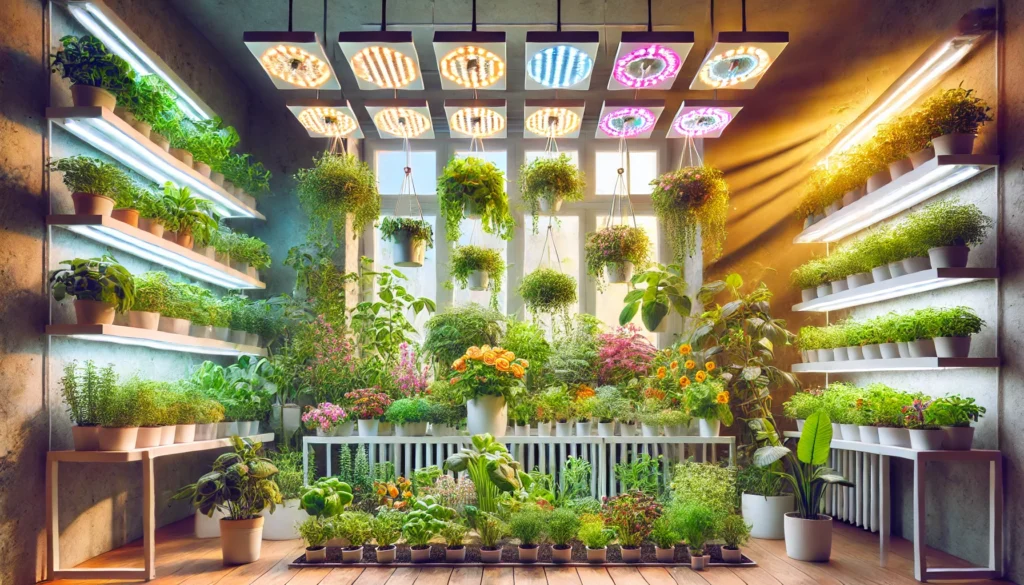
Best Grow Lights for Indoor Gardens: Choose the Right One for Healthy Plants
Growing plants indoors can be both rewarding and challenging. Without adequate sunlight, your plants may struggle to thrive, leading to slow growth and weak stems. This is where grow lights for indoor gardens come in—providing the right spectrum of light to support healthy plant development year-round. Whether you’re nurturing herbs, leafy greens, or flowering plants, choosing the best grow light can make all the difference. In this guide, we’ll explore the different types of grow lights, how to select the right one for your plants, and tips for maximizing their effectiveness to create a thriving indoor garden.
Table of Contents
ToggleWhy Grow Lights Are Essential for Indoor Gardens 🌿💡
Indoor gardening offers many rewards, but it also comes with challenges—especially when it comes to light. Without enough natural sunlight, your plants can struggle to thrive, resulting in weak growth and poor health. This is where grow lights for indoor gardens come in!
🌞 Mimicking Natural Sunlight
Grow lights provide the perfect spectrum of light that plants need for photosynthesis, much like natural sunlight. They ensure your plants receive the right balance of blue and red light for healthy growth.
🌱 Encouraging Year-Round Growth
Sunlight changes with the seasons, and in winter, it can be hard to get enough light indoors. With grow lights, you can keep your plants growing throughout the year, whether it’s the dead of winter or a cloudy day.
⚡ Promoting Stronger Plants
With the right light, plants grow stronger, faster, and healthier. For indoor fruiting plants, grow lights can even help increase flowering and fruit production. 🌸🍅
🏡 Suitable for Any Space
Grow lights are ideal for small apartments or larger garden setups. You can easily place them on shelves, countertops, or dedicated grow rooms, ensuring your plants get the light they need wherever they are.
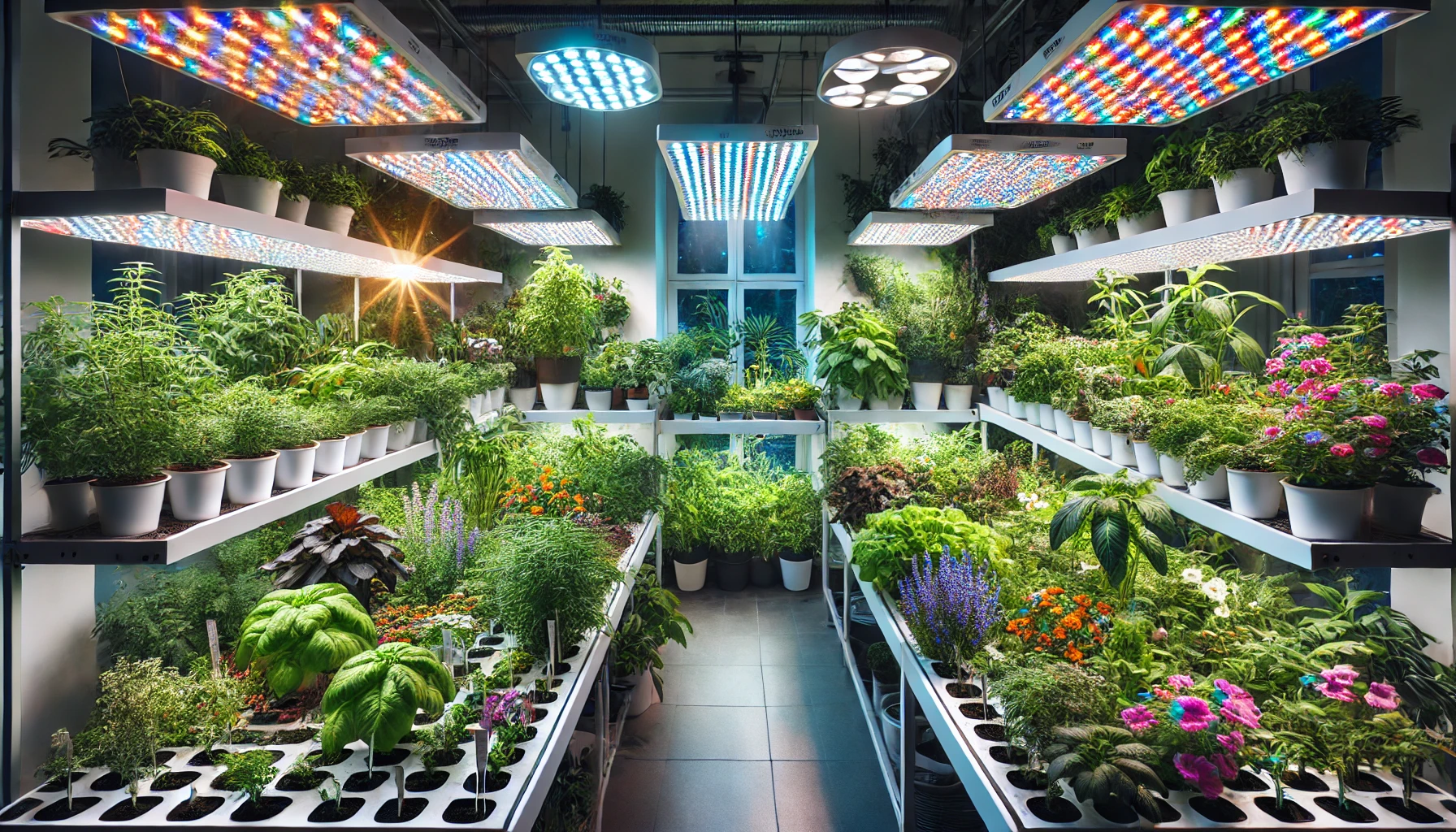
By choosing the right grow lights for indoor gardens, you give your plants the boost they need to thrive, no matter what space or season you’re working with! 🌟🌿
Types of Grow Lights for Indoor Plants 💡🌿
With so many types of grow lights for indoor plants, it’s important to understand which one is best for your space and plants. Here’s a breakdown of the most popular options:
🌟 Fluorescent Grow Lights
- Best For: Herbs, seedlings, and low-light houseplants.
- How It Works: These lights are energy-efficient and produce a soft light that’s perfect for small, low-light plants.
- Pros: Affordable, low heat, and gentle on young plants.
- Cons: Less intense light, not ideal for larger plants or flowering ones.
- Tip: Ideal for beginners or small indoor gardens growing greens.
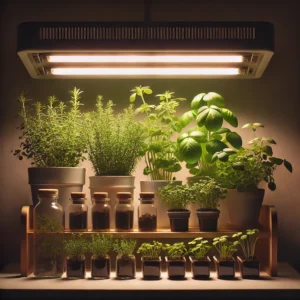
💡 LED Grow Lights
- Best For: All indoor plants, especially those that need a lot of light like flowering and fruiting plants.
- How It Works: LEDs offer a customizable spectrum, providing the perfect light for every growth stage.
- Pros: Energy-efficient, long-lasting, low heat output, and great for larger spaces.
- Cons: Higher upfront cost.
- Tip: Perfect for dedicated indoor gardeners who want to optimize plant growth over time.
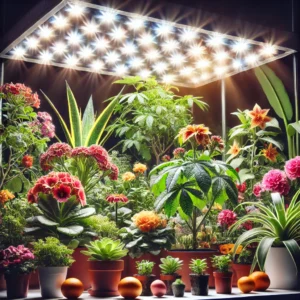
🔥 High-Intensity Discharge (HID) Grow Lights
- Best For: Large indoor gardens or commercial growers.
- How It Works: These lights produce powerful light, ideal for plants in need of intense light, like flowering and fruiting plants.
- Pros: Strong light intensity, supports heavy flowering and fruiting.
- Cons: High heat output, requires cooling, and consumes more energy.
- Tip: Best for advanced gardeners with larger setups.
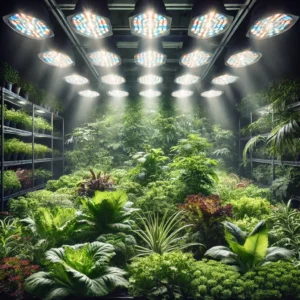
💡 Incandescent Grow Lights
- Best For: Not recommended for serious plant growth.
- How It Works: These are the standard light bulbs and not efficient for growing plants.
- Pros: Inexpensive, easy to find.
- Cons: Emit too much heat, offer little light for plants.
- Tip: Avoid these if you want healthy plants!
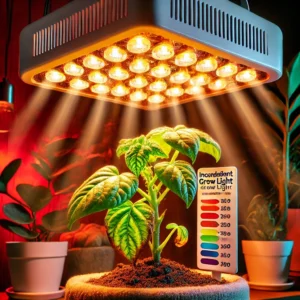
Choosing the right grow light depends on your plant needs and your gardening goals. Select the one that suits your space and helps your plants thrive! 🌱
How to Choose the Right Grow Light for Your Indoor Garden 🌱💡
Choosing the perfect grow light for your indoor garden can make a big difference in how your plants thrive. Here’s a quick guide to help you make the best choice based on your plants’ needs and your space:
🌿 Consider Your Plants’ Light Needs
Not all plants require the same amount of light. Some thrive in low-light conditions, while others need intense light to grow properly.
- Low-light plants (like ferns or peace lilies) can do well with fluorescent lights.
- High-light plants (like tomatoes or peppers) need LED or HID lights for optimal growth.
Tip: Check your plants’ light requirements before selecting your grow light.
🌞 Light Spectrum and Color
Plants need different types of light for different growth stages. The spectrum of light (how much blue or red light the bulb emits) is crucial for healthy growth:
- Blue light promotes leaf growth (good for leafy greens).
- Red light encourages flowering and fruiting (great for tomatoes or peppers).
Look for full-spectrum grow lights if you want a balanced light for all stages of plant growth.
Tip: Choose grow lights with a spectrum that matches your plant’s growth cycle.
⚡ Energy Efficiency and Cost
Energy efficiency is key to keeping your electricity bills low. While LED lights cost more upfront, they use less energy and last longer than fluorescent or HID lights.
- LEDs: Most energy-efficient, long-lasting, but higher initial cost.
- Fluorescent: Budget-friendly, but less intense light.
- HID: Powerful but energy-hungry.
Tip: If you want to save money in the long run, opt for LEDs.
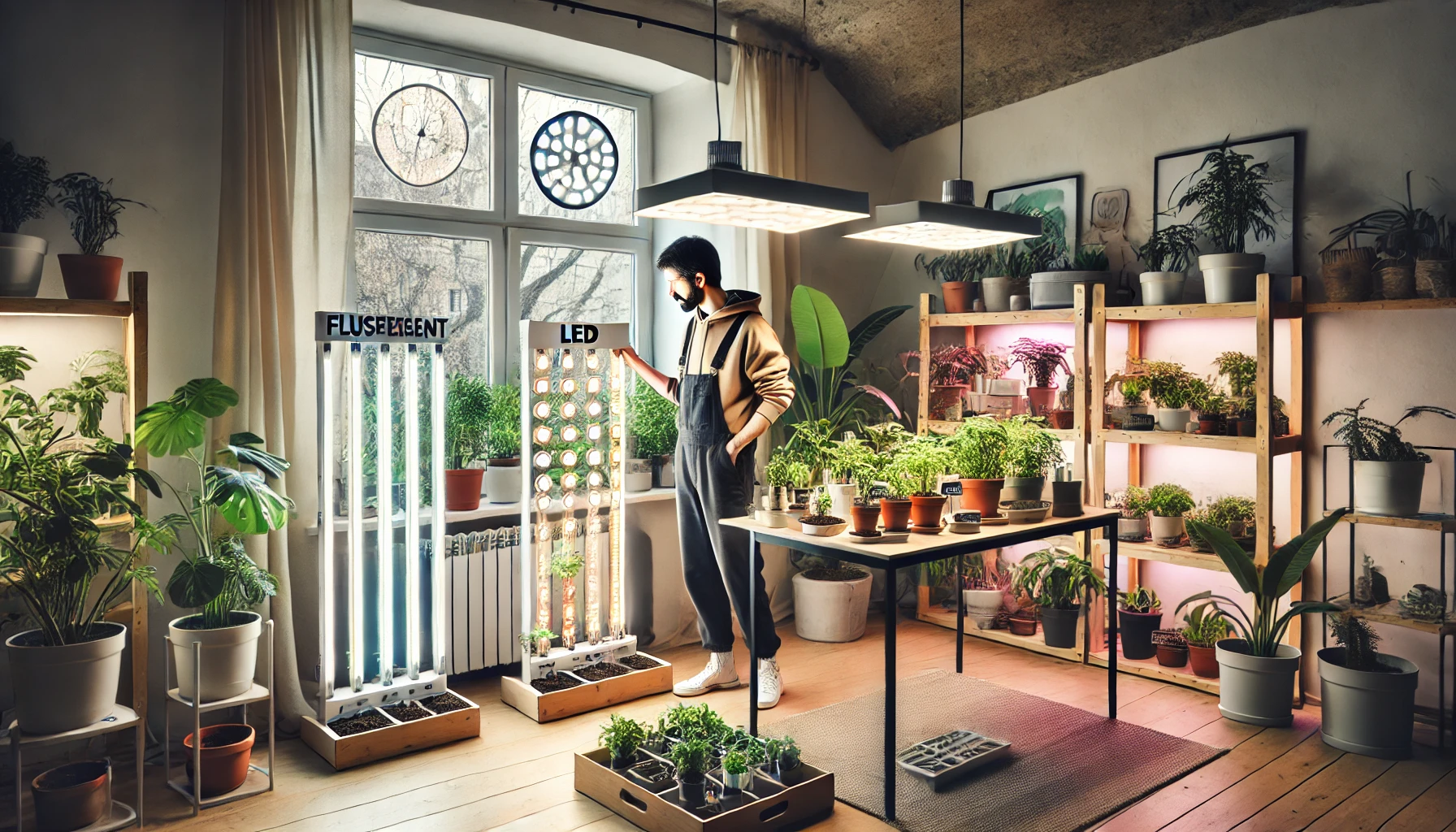
🏠 Space and Setup Considerations
The size of your indoor garden affects the type of grow light you should choose.
- For small setups, like a few potted plants or herbs, fluorescent or small LED lights are sufficient.
- For larger gardens, where you have multiple plants or even a grow room, HID or powerful LED lights are ideal.
Tip: Consider how you’ll mount or hang your grow light (overhead, on shelves, or free-standing) to suit your space.
By understanding your plants’ needs and your setup, you can select the best grow light for indoor gardens to keep your plants happy and healthy! 🌟🌿
Best Practices for Using Grow Lights Effectively 💡🌱
To get the most out of your grow lights for indoor gardens, it’s important to use them correctly. Follow these best practices to ensure your plants thrive:
🌞 Proper Light Placement and Distance
The distance between your plants and grow lights is crucial. If the light is too close, it can cause heat stress and burn the leaves; too far, and your plants won’t get enough light.
- LED lights should be placed about 12-24 inches above plants.
- Fluorescent lights can be placed about 6-12 inches away.
- HID lights need to be further away, about 24-36 inches, due to their intense heat.
Tip: Adjust the height as your plants grow to avoid light stress.
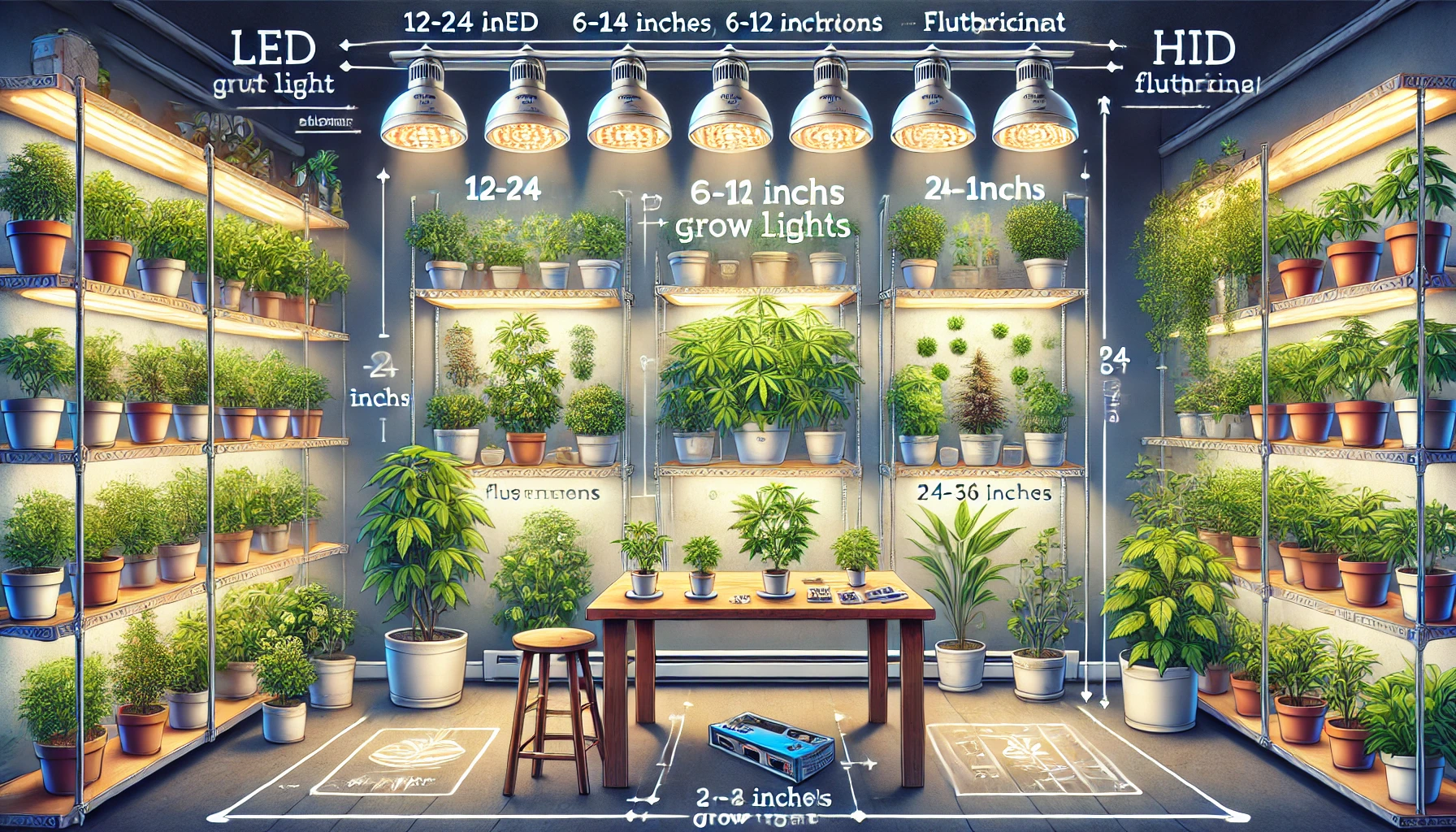
⏰ Set the Right Light Duration
Plants need the right balance of light and dark to thrive. Most indoor plants require 12-16 hours of light per day and about 8 hours of darkness.
- Leafy greens and herbs prefer about 12 hours of light.
- Flowering plants need longer light exposure (up to 16 hours).
Tip: Use a timer to automate light cycles for consistency and convenience.
🌡️ Manage Heat and Ventilation
Grow lights, especially HID types, can produce significant heat. This can lead to leaf burn or heat stress if not properly managed.
- Ensure your grow light setup has adequate ventilation.
- If using high-intensity lights, consider using cooling fans or ventilated hoods.
Tip: Keep a thermometer near your plants to monitor the temperature and prevent overheating.
💡 Rotate Your Plants
To ensure even light distribution, rotate your plants every few days. This helps all sides of the plant get enough exposure to light and prevents uneven growth.
Tip: Set a reminder to rotate plants every 3-4 days for uniform growth.
🔋 Maximize Energy Efficiency
While grow lights are important, energy efficiency matters too.
- If you have LED lights, they already use less energy than other types.
- Fluorescent lights are a good middle ground for efficiency.
- Use a timer to turn off lights when your plants don’t need them, saving energy and extending the life of your bulbs.
Tip: Consider using a smart timer to automatically adjust light schedules.
By following these best practices, you’ll optimize your grow lights and create the perfect environment for your indoor garden to flourish! 🌿🌟
Top Recommended Grow Lights for Indoor Gardening 💡🌱
When choosing the best grow lights for indoor gardens, it’s essential to consider factors like light spectrum, energy efficiency, and size of your setup. Here are some of the top recommended options that stand out for their effectiveness and quality:
Spider Farmer SF-1000 LED Grow Light 🌟
- Best For: All types of indoor plants, from leafy greens to flowering plants.
- Features: Full-spectrum LED, energy-efficient, low heat output, and easy to install.
- Pros: Provides optimal light for all growth stages, consumes less power, and has a long lifespan.
- Cons: A bit pricey, but a solid investment for serious gardeners.
Tip: Perfect for those looking for a powerful yet energy-efficient option.
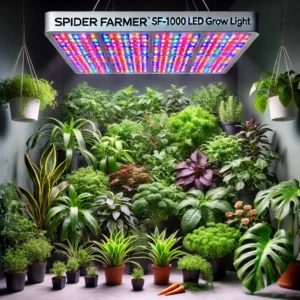
Phlizon CREE COB LED Grow Light 💡
- Best For: Medium to large indoor gardens, including fruiting plants.
- Features: Full spectrum, CREE COB LED technology, and efficient heat dissipation.
- Pros: Great for flowering and fruiting stages, easy to install, and durable.
- Cons: Heavier than some other models, so may require additional support.
Tip: A great choice for indoor gardeners with larger setups or more demanding plants.
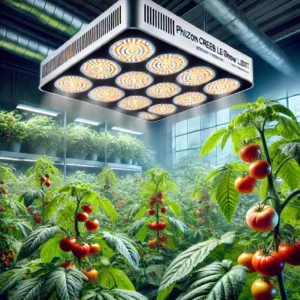
Vivosun 4-Pack T5 Fluorescent Grow Light 🌱
- Best For: Seedlings, herbs, and low-light houseplants.
- Features: Budget-friendly, compact, and efficient for small spaces.
- Pros: Perfect for beginners, easy to set up, and provides low heat.
- Cons: Less intense than LEDs, not suitable for larger plants.
Tip: Ideal for small indoor gardens or for starting seeds.
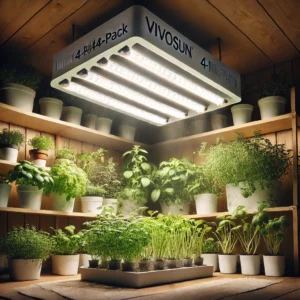
Mars Hydro TS 1000 LED Grow Light 🌞
- Best For: A wide variety of indoor plants, including flowering and fruiting plants.
- Features: Full-spectrum light, energy-efficient, and low heat production.
- Pros: Offers high light intensity for better growth and productivity, perfect for mid-sized gardens.
- Cons: May require additional setup for larger spaces.
Tip: A solid choice for intermediate gardeners who need more intensity.
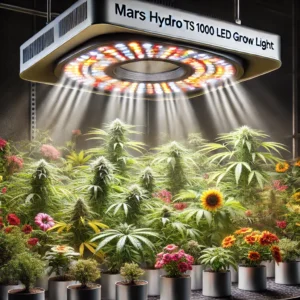
GE Lighting 3200 Lumen LED Grow Light 💡
- Best For: Smaller indoor gardens and plants that need moderate light.
- Features: Full spectrum, lightweight, and energy-efficient.
- Pros: Affordable, easy to use, and great for beginners or small spaces.
- Cons: Not as powerful as high-end LED or HID lights.
Tip: Great for casual gardeners or small, low-light plants.
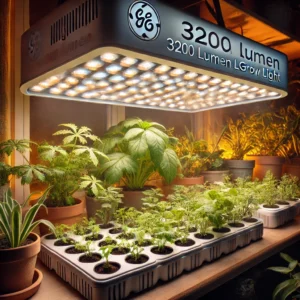
These top-rated grow lights for indoor gardens will help you create the perfect environment for your plants to flourish, no matter your gardening experience or space size! 🌱✨
Common Mistakes to Avoid When Using Grow Lights 💡🚫
While grow lights are a fantastic tool for indoor gardening, there are a few common mistakes that can hinder plant growth. Here are the top mistakes to avoid to ensure your plants thrive under artificial light:
Placing Lights Too Close to Plants 🌞
Placing grow lights too close to plants can lead to heat stress or even leaf burn. Plants need proper space to receive light without suffering from excess heat.
Tip: Follow the manufacturer’s recommended distance and adjust as your plants grow.
Using the Wrong Light Spectrum 🌈
Different plants have different light needs. Using a light with an incorrect spectrum can lead to poor growth, weak stems, and lack of flowering or fruiting.
Tip: Choose full-spectrum LED lights for a balanced light, or opt for blue light for vegetative growth and red light for flowering plants.
Not Providing Enough Light Duration ⏰
Plants need 12-16 hours of light per day to grow well, depending on their type. Too little light can slow growth, while too much can cause stress.
Tip: Set a timer for consistency and provide the correct amount of light each day.
Ignoring Plant Rotation 🔄
Not rotating your plants can lead to uneven growth as only the side facing the light gets the benefit.
Tip: Rotate plants every few days to ensure all sides get equal light exposure.
Overlooking Heat Management 🌡️
Certain grow lights, especially HID lights, can produce a lot of heat. Without proper ventilation, this can stress your plants and cause leaf burn or slow growth.
Tip: Ensure adequate airflow and use cooling fans or heat sinks when using high-intensity lights.
Not Adjusting for Plant Growth 🌱
As plants grow, they require more light. If you don’t adjust the height of your grow lights, your plants may not receive adequate light.
Tip: Raise or lower lights as your plants grow taller to maintain proper distance and light intensity.
By avoiding these common mistakes, you’ll ensure your grow lights work effectively, giving your plants the best chance to thrive indoors! 🌿✨
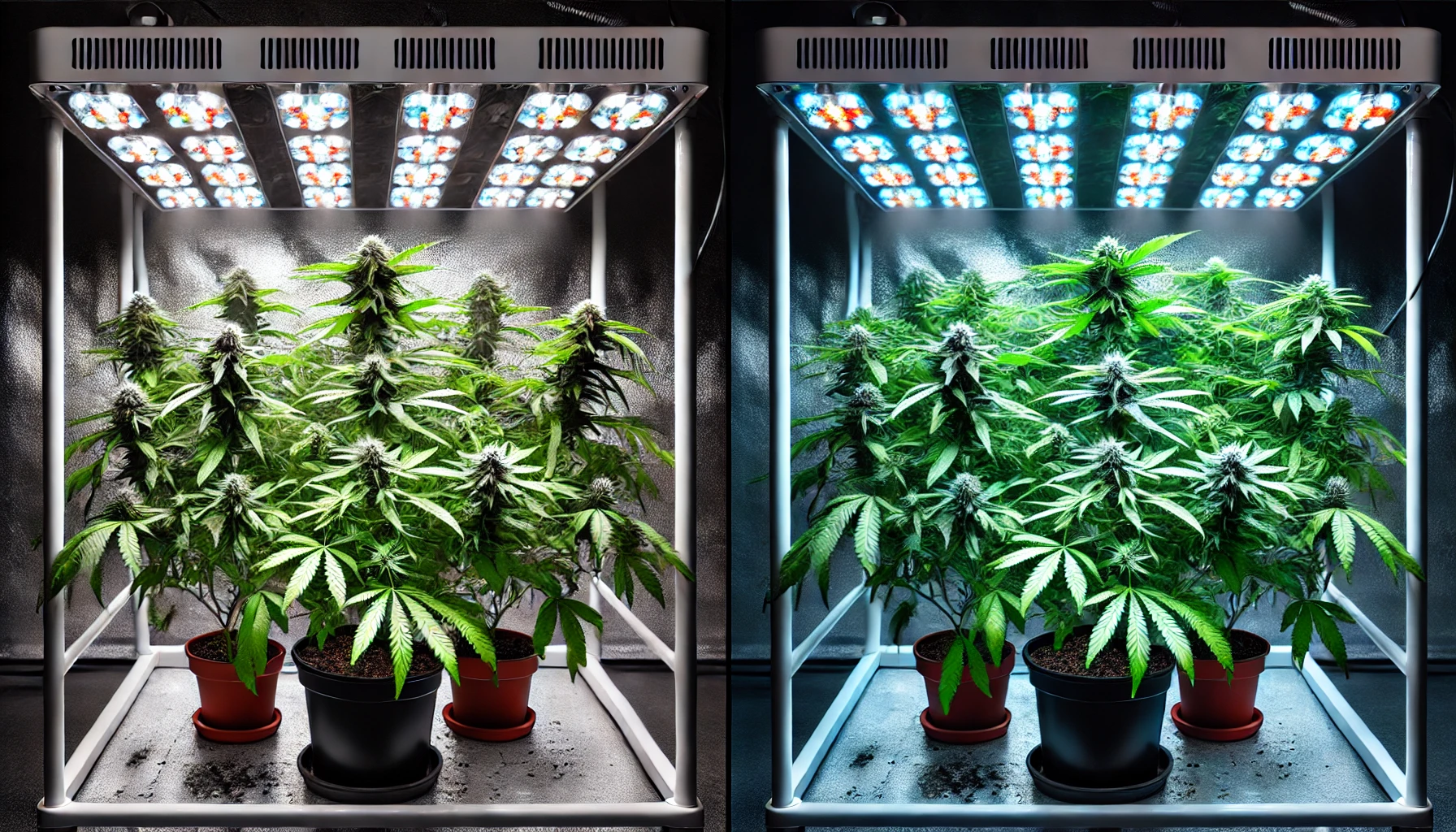
Choosing the right grow lights for indoor gardens and using them effectively is key to helping your plants thrive year-round. With the right lighting setup, you can provide your indoor garden with the energy it needs to grow strong and healthy, whether you’re growing herbs, flowers, or houseplants.
Remember to consider your plants’ specific light needs, choose the appropriate light type, and follow best practices for placement, duration, and heat management. Avoiding common mistakes and adjusting your grow light setup as your plants grow will ensure long-term success.
With the right tools and a little care, you can create a flourishing indoor garden that will bring beauty and fresh produce into your home. Happy gardening! 🌱✨
Frequently Asked Questions (FAQ)
What type of grow light is best for indoor plants?
Full-spectrum LED grow lights are the best choice as they mimic natural sunlight and provide the necessary wavelengths for plant growth.
How many hours should grow lights be on?
Most plants need 12 to 16 hours of light per day, depending on their growth stage and type. A timer can help maintain a consistent schedule.
Can any LED light be used as a grow light?
Not all LED lights are suitable for plant growth. Grow lights are designed to emit specific wavelengths needed for photosynthesis, unlike regular LEDs.
How far should grow lights be from plants?
The distance depends on the light’s intensity. LED grow lights are usually placed 12 to 24 inches above plants, while fluorescent lights can be closer.
Do grow lights get hot?
LED grow lights produce minimal heat, but HID and fluorescent lights can generate significant warmth and may require ventilation.
Which color spectrum is best for plant growth?
Blue light promotes leafy growth, red light encourages flowering and fruiting, and full-spectrum lights support all growth stages.
Can grow lights replace natural sunlight?
Grow lights can supplement or replace natural sunlight, especially in low-light conditions, but plants may benefit from occasional natural light exposure.
Are grow lights expensive to run?
LED grow lights are energy-efficient and cost-effective, consuming less electricity than traditional lighting options like HID or fluorescent bulbs.
